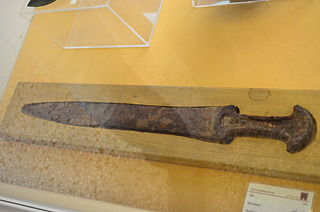 W
WThe acinaces, also spelled akinakes or akinaka is a type of dagger or short sword used mainly in the first millennium BC in the eastern Mediterranean region, especially by the Medes, Scythians, Persians and Caspii, then by the Greeks.
 W
WThe Saif, sometimes simply called Arabian sword, has its origins in Arabia prior to the 7th century. Not much is known about this particular weapon, other than what Al-Kindi wrote in his treatise On Swords in the 9th century.
 W
WA kilij is a type of one-handed, single-edged and moderately curved scimitar used by the Timurid Empire, Mamluk Empire, Ottoman Empire, and the later Turkic Khanates of Central Asia and Eurasian steppes. These blades developed from earlier Turko-Mongol sabers that were in use in lands invaded or influenced by the Turkic peoples.
 W
WA Mameluke sword is a cross-hilted, curved, scimitar-like sword historically derived from sabres used by Mamluk warriors of Mamluk Egypt after whom the sword is named. Egypt was, at least nominally, part of the Ottoman Empire and the sword most commonly used in Egypt was the same as used elsewhere in the empire, the kilij.
 W
WNader Shah's Sword refers to the sword carried by Iranian ruler Nader Shah. It is located in Tehran, Iran. Under later Iranian ruler Fath-Ali Shah Qajar, some fifty years or more later, it was inscribed and embellished. The scabbard of the sword is covered with diamonds. The modern historian Michael Axworthy notes that "Nader used the imagery of the sword to describe himself on a number of occasions".
 W
WA scimitar is a backsword with a convex curved blade associated with Middle Eastern, South Asian, or North African cultures. A European term, scimitar does not refer to one specific sword type, but an assortment of different Eastern curved swords inspired by types introduced to the Middle East by Central Asian ghilmans. These swords include the Persian shamshir, the Arab saif, the Indian talwar, the North African nimcha, and the Turkish kilij.
 W
WA shamshir is a type of Persian/Iranian sword with a radical curve. The name is derived from the shamshīr, which means "sword" in the Persian language. The curved "scimitar" sword family includes the shamshir, kilij, talwar, pulwar and nimcha.
 W
WZulfiqar, also spelled Zu al-Faqar, Zulfikar, Dhu al-Faqar, Dhulfaqar or Dhulfiqar, is the sword of Ali ibn Abi Talib. It was historically frequently depicted as a scissor-like double bladed sword on Muslim flags, and it is commonly shown in Shia depictions of Ali and in the form of jewelry functioning as talismans as a scimitar terminating in two points.